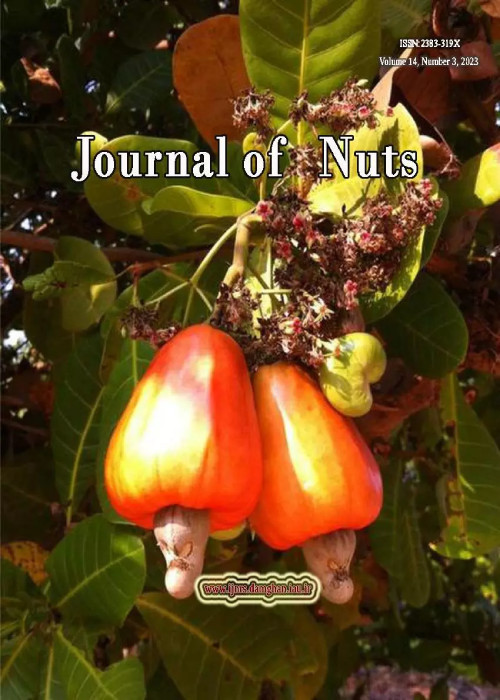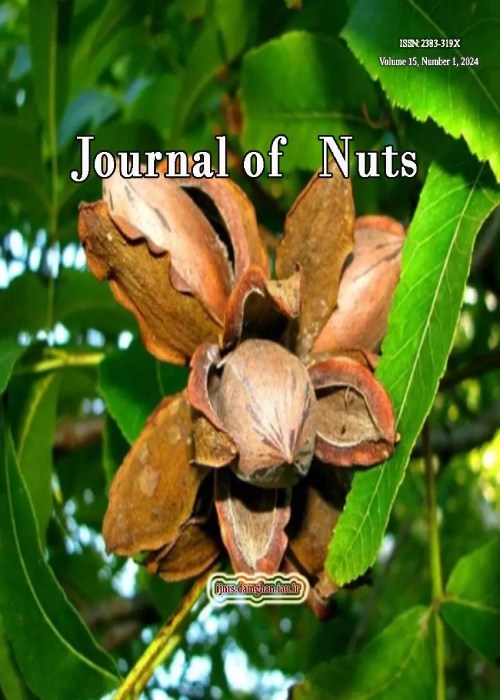فهرست مطالب

Journal of Nuts
Volume:14 Issue: 3, Summer 2023
- تاریخ انتشار: 1402/06/10
- تعداد عناوین: 6
-
-
Pages 173-180
The efficacy of Pyradim ® DF with pyraclostrobin+dimetomorf active ingredient was evaluated in comparison with fungicides Captan, Nordox, Mishocap in the control of pistachio Alternaria late blight. The experiment was carried out in Markazi (Zarandieh), Kerman and Semnan in a Randomized Complete Block Design (RCBD) with 8 treatments and 4 replications. Treatments were applied at two stages (before bud swelling and after the petals fall and fruit set). The data were analyzed using SAS software and mean comparison of disease severity and disease incidence percentages were done by Duncan's multiple range test (P =5%). The results showed that Pyradim with dosage of 1 and 0.75 per thousand has a good efficacy in disease control. So that the efficiency of dosage 1g L-1 in reducing the severity of the disease compared to the control without spraying was about 88% in Zarandieh and about 77% in Kerman and Semnan. The efficacy of Pyradim at the dose of 0.75g L-1 in Zarandieh, Kerman and Semnan was about 76%, 72% and 74%, respectively, but the dose of 0.5g L-1 Pyradim was not acceptable and in the three studied areas was between 52 to 55%. Captan fungicide also had acceptable efficacy in controlling pistachio Alternaria late blight disease, so that its efficiency was more than 70% in Kerman and Semnan and 68% in Zarandieh. In contrast, Nordox and Mishocap fungicides did not have good efficiency. Therefore, 0.75g L-1 pyradim is recommended for controlling pistachio Alternaria late blight disease.
Keywords: Alternaria Late Blight, Pistachio, fungicides, Pyradim -
Pages 181-190In recent years, the demand for walnuts has increased due to their recognition as a nutritious food and a versatile ingredient in cooking and baking. As a result, walnut production has become a significant industry in many countries, providing income and employment opportunities for growers and processors. Despite the fact that one of the most important products in the world and Syria is walnuts, there has been little research on irrigation and, in particular, water productivity. Therefore, the purpose of this study is to examine the irrigation status and water productivity in several walnut orchards in As-Suwayda province, which is a significant production area for this product. In the course of this research, water productivity, irrigation water volume, and the crop performance of walnut orchards in three of the most important producing locations of this commodity in the province of As-Suwayda (Sweida) were evaluated and compared. Drip irrigation and surface irrigation methods were investigated. The t-test was used to compare irrigation water levels in orchards with gross water requirements. Drip irrigation systems in orchards save around 1700 m3 ha-1 of irrigation water, reduce yields by an average of 145 kg ha-1, and boost water productivity by roughly 0.02 kg m3, according to the findings, but none of these differences were statistically significant at the 5% level. In general, there was not a discernible difference found between drip and surface irrigation systems in terms of performance values, amount of water applied, or water productivity.Keywords: drip irrigation, Irrigation scheduling, Surface irrigation, water requirement
-
Pages 191-199Seed protection is a key element in plant survival and plant dispersion. In hazelnuts, shell lignification begins from the tip to the basal scar. Therefore, hardening time is a race between seed survival against environmental stress. While new pests and stochastic weather events are increasing, fundamental shell lignification features are missing in the common Segorbe cultivar. In this purpose, progress of lignification was studied using hardness and morphological changes in fresh and dried Segorbe hazelnuts collected weekly in 2020 and 2021, respectively. The growing degree days (GDD) were calculated for key lignification process stages. In dried hazelnuts, the lignification process causes morphological deformation lead to belted hazelnut symptoms. Lignification increased progressively from week 22 (1353.6 GDD) to week 26 (1353.6 GDD). Shell length was 48–84% of their final size. The shell was fully lignified at week 27 with a kernel size of 4.99±0.32 mm. In fresh nuts, shell size increased from 83 to 92%, and hardening increased by a factor of 2.85, reaching 21 kgf, between weeks 25 and 26 (2272.8 GDD), with a kernel size of 4.75±2.05 mm. Lignification occurs in four weeks. When kernel size is ~5 mm, and shell growth ends, a hard wall protects the kernel from stressors. Belted hazelnut symptoms, reflected in the ratio of lignified and shriveled shell parts, and shell hardness, are discussed in the context of the susceptibility of Segorbe cultivars to environmental stressors.Keywords: Belted hazelnuts, Environmental stressors, Filbert, growth curve, Phenology, Sclereid, Shell hardening
-
Pages 201-210In the western Iranian provinces of Kurdistan and Kermanshah as well as the northern Kurdistan Region of Iraq, there is a hilly terrain called Hawraman. It’s called the biosphere reserve of Iraq due to its high biodiversity. In this study, the planting of saplings of the Norway spruce (Picea abies) and Austrian pine (Pinus nigra) species was investigated quantitatively and qualitatively using 20 square sample plots with measurements of 12×12 meters that were randomly chosen in the selection area. The diameter of the collar, the overall height, the freshness of the seedlings, and the survival indicators were evaluated and measured in each sample plot. Picea abies outperformed Pinus nigra in terms of diameter and height, according to a statistical comparison between the two species in the same direction and slope (Picea abies: 1.34 cm and 0.32 m, Pinus nigra: 0.71 cm and 0.21 m). There was no significant difference in the percentage of survival between the two species. In terms of freshness, a comparison of these two species revealed that the Picea abies species had a higher level of freshness than the Pinus nigra species.Keywords: Biosphere reserve of Iraq, Picea abies, Pinus nigra
-
Pages 211-227To study the effects of different concentrations of phenylalanine, and calcium nitrate under cold stress on Pistacia vera L. 'Abbas Ali' cultivar seedlings, a factorial experiment was performed with three factors of phenylalanine at three levels of calcium nitrate, and temperature based on a completely random design with three replications. The findings demonstrated that the effects of phenylalanine, calcium nitrate, temperature, as well as their interactions, were significant for all studied features. By simultaneous use of 2.5 mM of phenylalanine, and 5 ppm of calcium nitrate, electrolyte leakage reduced by 19% compared to the control sample at -3°C. Furthermore, when the temperature reduced from zero to -3°C, the concentration of proline increased from 2.3 to 3.1 μg g⁻¹ fw compared to the control seedlings. By simultaneous use of the highest concentrations of phenylalanine, and calcium nitrate, phenolic compounds, and soluble sugar increased. However, the interactions of phenylalanine×calcium nitrate, cold×phenylalanine, and phenylalanine×calcium nitrate×cold were not significant on the content of proline. A significant positive correlation was between proline, and soluble sugar at the probability level of 1% (r=0.87**). A significant negative correlation was between electrolyte leakage and chlorophyll fluorescence at the probability level of 1% (r=- 0.68**).Keywords: Carotenoid, Chlorophyll, Cold stress, Pistacia vera L, Proline
-
Pages 229-237Chestnuts are highly valued for their nutritional and practical qualities in addition to their organoleptic qualities. Chestnut tree is extremely susceptible to pollutants, summer droughts, high soil moisture, and harsh frosts. Natural forests that are home to chestnuts can be found in Kurdistan region of Iraq. Hand-planted chestnuts are a common sight in several provinces around the country. It is possible to get medical benefit from chestnut leaves (Castanea sativa) and catkins. The purpose of this study was to investigate the impact that aqueous extracts of chestnut leaves and catkins have on seven different strains of bacteria: Bacillus subtilis, Bacillus cereus, Staphylococcus aureus, Micrococcus luteus, Escherichia coli, Pseudomonas aeruginosa, and Yersinia enterocolitica. This study selected three harvesting locations: Babulah, Argen, and Charbut. The samples collected from chestnut trees were dried and processed. Antimicrobial effects of the extracts were tested on various gram-positive and gram-negative bacteria using the Kirby-Bauer disk diffusion method. Ciprofloxacin (5 μg) and ceftizoxime (30 μg) discs were used to compare the antibacterial properties of the extracts. Statistical analyses were performed using SPSS software. According to the findings, the antibacterial qualities of chestnuts shifted depending on the environment in which they were grown. The catkins, but not the leaves, exhibited antibacterial activity. The leaves did not show any antibacterial activity. Gram-positive bacteria were more sensitive, and antibiotics had greater antibacterial effects than extracts.Keywords: Aqueous extract, bacteriology, Chestnut, Castanea sativa, Irrigation, Natural forests


